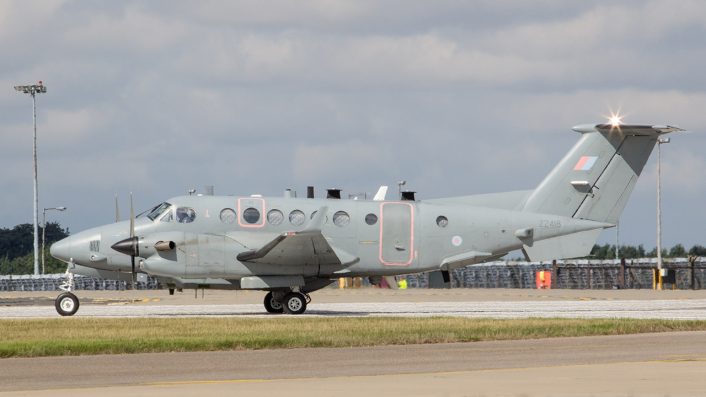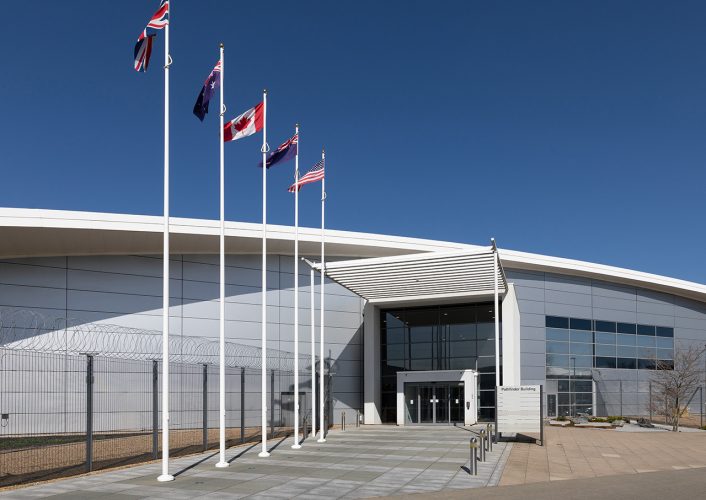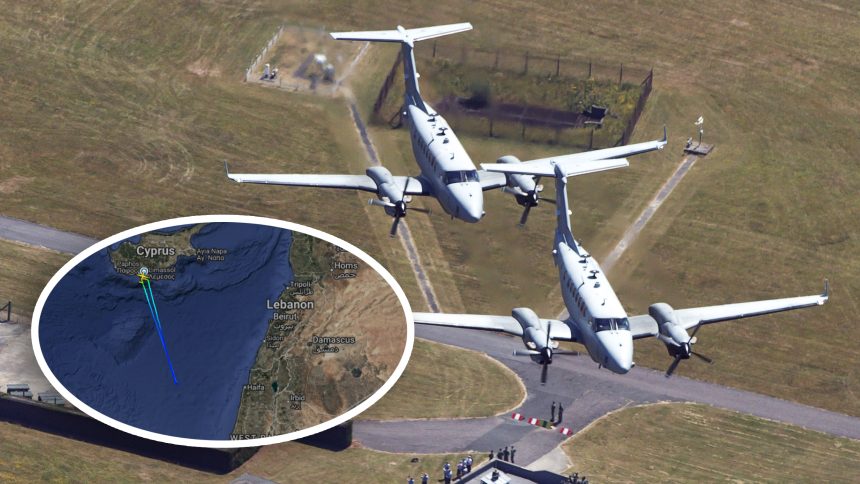Let’s look at what we know about the UK’s flights over Gaza, what we can tell from them, what has been claimed, and what they might signal about UK-Israel relations.
Since the Oct. 7, 2023 attack by Hamas against Israel, and Israel’s subsequent military response in Gaza, the United Kingdom’s Royal Air Force has kept a close eye on ongoing events using RAF Akrotiri-based Shadow aircraft. The Shadow, based on the Beechcraft B350, carries electro-optical/infrared sensors, as well as communications and electronics intelligence gathering equipment. Towards the end of July, the Shadow fleet at Akrotiri was reduced and some sorties taken over by privately contracted aircraft. For the purposes of this article, all references to the flights include both RAF and contracted missions.
As testimonials of war crimes are presented before the United Nations for review, the intelligence sorties – which can often be tracked publicly on websites like Flightradar24 – have become a frequently used example of the UK providing support to Israeli operations.

The UK Government maintains that these missions are tasked with locating remaining hostages within Gaza, with the information flow to Israel itself strictly controlled. Most likely, in addition to this, the Shadows have collected information on Israeli operations themselves for the purpose of providing valuable and accurate intelligence back to senior officials in the UK, rather than relying on third parties. Importantly, the intelligence gathered could also be utilised in the UK’s assessments of war crime allegations, and could produce crucial evidence in either proving or disproving cases.
However, some have openly stated as a matter of fact that the raw data gathered by these aircraft is being provided in real time to Israeli forces. While discussion of – and, indeed, questioning of – these missions in the public realm should be welcomed, from a freedom of speech, belief, and discussion perspective, it would seem that the allegations are being made without full understanding of aviation and intelligence operations both past and present. On the whole, the idea that the RAF’s flights are feeding their data directly into Israel’s hands is unlikely. This is for various reasons, which will be elaborated upon below.
Intelligence Gathering Doctrine – A Brief Insight
The UK, as well as the U.S., and by extension Australia, New Zealand, and Canada as Five Eyes member states, has taken the firm position since the end of the Second World War that if intelligence is there to collect then it must be collected. Even for conflicts not directly involving these powers, harnessing this intelligence can be critical to understanding the strategic, economic, and political ramifications of world events.
There have been frequent battles between military and intelligence forces and the governments of their day regarding the exact nature of intelligence sharing between them. Governments always want the latest produce, but those who collect and process intelligence lean towards caution, preferring to only share properly constructed intelligence products – analysed, interpreted, and assessed extensively for accuracy, sometimes using ‘red team’ methodologies.
For this reason alone, the output of raw data gathered by UK aircraft is likely to follow a very limited and well-constructed trail, starting with intelligence analysts in the Royal Air Force. Further up the chain, Defence Intelligence, based at RAF Wyton, is responsible for all intelligence gathering within the Ministry of Defence, reporting in turn to the Joint Intelligence Committee (JIC). At the JIC, Defence Intelligence convenes with the Security Service (MI5), Secret Intelligence Service (MI6), and Government Communications Headquarters (GCHQ) to act as an interagency intelligence assessor and overseer.

The JIC is the body responsible for delivering intelligence to the Government. Only at the highest levels – likely the Prime Minister and/or the Foreign Secretary – could the exact nature of the UK’s intelligence sharing with Israel be decided upon. Information on certain topics – an impending terrorist attack, or the exact location of a hostage – might be allowed to be shared under a delegated agreement, which could have been negotiated with Israel in return for freedom to operate in Gazan airspace unrestricted – but anything contentious would likely require ministerial approval.
In fact, the simplest method of travel for intelligence data produced by the UK going to Israel would be through the United States. As Five Eyes (FVEY) partners, and the two core signatories of the still classified UKUSA Agreement, the intelligence agencies of these two nations are almost inextricably intertwined to the point that even Presidential decrees to cut intelligence sharing during tense relations were not completely effective. The GCHQ station in Cyprus is one of the UK’s most important intelligence gathering outposts, hoovering up communications and electronic emissions throughout the Middle East.

Many GCHQ facilities are staffed in conjunction with the U.S. National Security Agency (NSA), and so intelligence collected at these facilities is, at least historically, known to be simultaneously available across the FVEY alliance. It would, therefore, be within the power of the U.S. to then feed the data through to Israel.
Intelligence sharing with Israel has, in fact, been one of the biggest causes of historical friction within FVEY. British Prime Minister Edward Heath, who positioned the UK as a neutral party in the 1973 Arab-Israeli Yom Kippur war, objected to the potential provision of aerial imagery captured by UK-based SR-71 Blackbirds to Israel. In response, the U.S. Air Force mounted several direct sorties from the United States, chaining the SR-71’s mammoth flight together with the specially-adapted KC-135Q Stratotanker tankers.
Israel’s Intelligence Capabilities
While we know that the U.S. and UK have an extraordinary capacity for intelligence gathering, the reality is that Israel is also one of the world’s intelligence powerhouses. GCHQ is known to have closely co-operated with Israeli intelligence agencies – though, it should also be noted that Israel itself has been a target of UK (and U.S.) spying.
As a producer of well-equipped unmanned aircraft, as well as a wide array of intelligence gathering systems and electronics, Israel is already well positioned to collect whatever intelligence it wants over Gaza. While the geopolitical reliance on the United States is difficult to escape from, Israel has positioned itself well for holding out on its own with sovereign capabilities that are independent of external influence. To put it simply – there is little that can be collected by RAF Shadows or contractors over Gaza that is not already within the reach of the Israeli military or security services. The question, therefore, is, why would Israel be relying on this intelligence data – especially while the UK is reportedly considered an ‘unreliable’ ally?
The IDF has been keeping a close watch on Sinai and Gaza coastline for hours till now. Three G550 SIGINT/AEW&C aircraft have taken off, with two of them actively flying off Gaza and Egypt’s Sinai. They’re being escorted by a Boeing 707 tanker for refueling support. pic.twitter.com/PEtEVkATfd
— Egypt’s Intel Observer (@EGYOSINT) April 27, 2025
Additionally, as mentioned above, Israel would also be able to firstly rely upon intelligence reports from the United States, who remain a close ally. While U.S. flights are rarely tracked on public websites, it is known that MQ-9 Reapers from Sigonella have flown sorties over Gaza and likely continue to do so in addition to other aircraft as well as satellites. Space capabilities are where Israel somewhat falls short, with geographic constraints limiting the country’s ability to deliver higher payloads into orbit, though given the regional focus of its operations it is an area of lower importance compared to the U.S.
Earlier today, a drone that was tracked from a position off the coast of Crete loitered over Gaza for just under 3 hours.
What wasn’t visible on flight trackers were two MQ-9A Extended Range Reaper drones also in the area: REMIX22 & REMIX55 from NAS Sigonella. #ADSB #E9D001 1/2 https://t.co/wtqFbS6CQe pic.twitter.com/rbN4etxf4F
— Amelia Smith (@ameliairheart) October 29, 2023
Transponder Tales
A running theme in reports of the UK’s intelligence, surveillance, and reconnaissance (ISR) mission over Gaza is that the aircraft, tracking on websites like Flightradar24, are ‘not meant to be seen’. Commentary alleges that pilots have forgotten to turn off their transponders, accidentally revealing to the world what they are up to.
While there are certainly cases where transponders have been active and transmitting on public modes in situations where, usually, they wouldn’t be, the consistent appearance of these aircraft online is an almost certain indication that flying with the transponder enabled and not in a degraded mode is standard operating procedure.
Transponders are commonly misunderstood even by those considered to be seasoned ‘flight trackers’. On many occasions where aircraft are alleged to have flown with their transponder “off”, in reality you would find this to not be the case. Tracking sites, like Flightradar24, ADS-B Exchange, Planefinder and the like, rely largely on transponders broadcasting ADS-B or Mode S in order to display them on a map. In the case of ADS-B, the aircraft transmits its GPS location – for Mode S, with no positional data, the aircraft must be located using multilateration with multiple receivers.
However, these are not the only transponder modes, and very frequently military aircraft will fly using Mode 3. Mode 3, known in the civilian world as Mode A/C, responds to interrogation by secondary surveillance radars (SSRs) with an aircraft’s altitude and squawk code. No positional data is transmitted, nor any identifying data like an ICAO address. It is theoretically possible to track Mode 3 only aircraft as a civilian, and some services are experimenting with this, but it is not a widespread or completely foolproof process.
For air traffic controllers, the aircraft can appear on their display as usual, using the ‘real’ primary radar to assist with positional data. There are also military only modes, including cryptographically secured versions of Mode S and ADS-B. If a military aircraft, like the Shadow, wished to hide its position, it would – and they have done so in the past.
Conclusion
None of us in the civilian domain know for sure how much information is flowing from the RAF’s flights to Israel’s intelligence assessments, but using the above we can likely discount many of the more dramatic claims that have been making the rounds online.
That is not to say that official lines should always be taken at face value, but equally the claims of social media talking heads should also be examined very closely. In fact, I would encourage everyone to fact check this article itself. Every effort has been made to be as matter-of-fact and logical as possible, but complex subjects breed complex stories.
As is the nature of the intelligence business, it will probably be decades before any real insight into the daily operations we can view in our browser windows can come to light – if it ever does at all.









